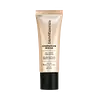What's inside
What's inside
 Key Ingredients
Key Ingredients

 Benefits
Benefits

 Concerns
Concerns

 Ingredients Side-by-side
Ingredients Side-by-side

Centella Asiatica Leaf Water
Skin ConditioningCaprylic/Capric Triglyceride
MaskingCetyl Ethylhexanoate
EmollientButylene Glycol
HumectantCI 77891
Cosmetic ColorantDimethicone
EmollientPropylene Glycol
Humectant1,2-Hexanediol
Skin ConditioningHexyl Laurate
EmollientCetyl PEG/PPG-10/1 Dimethicone
EmulsifyingNiacinamide
SmoothingMagnesium Sulfate
Glycerin
HumectantLavandula Angustifolia Oil
MaskingCitrus Aurantifolia Fruit Extract
Skin ConditioningArtemisia Capillaris Extract
Olea Europaea Fruit Extract
BleachingAnemarrhena Asphodeloides Root Extract
Skin ConditioningSorbitan Sesquioleate
EmulsifyingMicrocrystalline Wax
Emulsion StabilisingTocopheryl Acetate
AntioxidantZinc Stearate
Cosmetic ColorantSilica Dimethyl Silylate
EmollientHydroxyacetophenone
AntioxidantAluminum Hydroxide
EmollientTriethoxycaprylylsilane
Adenosine
Skin ConditioningWater
Skin ConditioningStearic Acid
CleansingCaprylyl Glycol
EmollientGlutathione
Panthenol
Skin ConditioningPropanediol
SolventHydrogenated Polyisobutene
EmollientHydroxyethylcellulose
Emulsion StabilisingPentaerythrityl Tetra-Di-T-Butyl Hydroxyhydrocinnamate
AntioxidantSodium Chloride
MaskingHydrogenated Lecithin
EmulsifyingGlycine Soja Sterols
EmollientHydroxydecyl Ubiquinone
AntioxidantPalmitoyl Tripeptide-5
Skin ConditioningEthylhexylglycerin
Skin ConditioningAcetyl Hexapeptide-8
HumectantAllantoin
Skin ConditioningPalmitoyl Pentapeptide-4
Skin ConditioningTocopherol
AntioxidantDisodium EDTA
Linalool
PerfumingCI 77492
Cosmetic ColorantCI 77491
Cosmetic ColorantCI 77499
Cosmetic ColorantCentella Asiatica Leaf Water, Caprylic/Capric Triglyceride, Cetyl Ethylhexanoate, Butylene Glycol, CI 77891, Dimethicone, Propylene Glycol, 1,2-Hexanediol, Hexyl Laurate, Cetyl PEG/PPG-10/1 Dimethicone, Niacinamide, Magnesium Sulfate, Glycerin, Lavandula Angustifolia Oil, Citrus Aurantifolia Fruit Extract, Artemisia Capillaris Extract, Olea Europaea Fruit Extract, Anemarrhena Asphodeloides Root Extract, Sorbitan Sesquioleate, Microcrystalline Wax, Tocopheryl Acetate, Zinc Stearate, Silica Dimethyl Silylate, Hydroxyacetophenone, Aluminum Hydroxide, Triethoxycaprylylsilane, Adenosine, Water, Stearic Acid, Caprylyl Glycol, Glutathione, Panthenol, Propanediol, Hydrogenated Polyisobutene, Hydroxyethylcellulose, Pentaerythrityl Tetra-Di-T-Butyl Hydroxyhydrocinnamate, Sodium Chloride, Hydrogenated Lecithin, Glycine Soja Sterols, Hydroxydecyl Ubiquinone, Palmitoyl Tripeptide-5, Ethylhexylglycerin, Acetyl Hexapeptide-8, Allantoin, Palmitoyl Pentapeptide-4, Tocopherol, Disodium EDTA, Linalool, CI 77492, CI 77491, CI 77499
Titanium Dioxide
Cosmetic ColorantWater
Skin ConditioningCoconut Alkanes
EmollientPropanediol
SolventSqualane
EmollientMica
Cosmetic ColorantTrehalose
HumectantGlycerin
HumectantSorbitan Sesquiisostearate
EmulsifyingAgar
MaskingIsostearic Acid
CleansingPolysorbate 60
EmulsifyingSilica
AbrasiveGlobularia Cordifolia Callus Culture Extract
Skin ConditioningSalicornia Herbacea Extract
Skin ConditioningMelilotus Officinalis Extract
AstringentSodium Hyaluronate
HumectantCoco-Caprylate/Caprate
EmollientAluminum Hydroxide
EmollientHydrogen Dimethicone
Polyglyceryl-4 Laurate/Succinate
Caprylic/Capric Triglyceride
MaskingButylene Glycol
HumectantLauroyl Lysine
Skin ConditioningCellulose Gum
Emulsion StabilisingCalcium Chloride
AstringentSuccinoglycan
Skin ConditioningSynthetic Fluorphlogopite
Magnesium Chloride
Potassium Chloride
Coumarin
PerfumingPotassium Sorbate
PreservativePhenoxyethanol
PreservativeIron Oxides
CI 15850
Cosmetic ColorantTitanium Dioxide, Water, Coconut Alkanes, Propanediol, Squalane, Mica, Trehalose, Glycerin, Sorbitan Sesquiisostearate, Agar, Isostearic Acid, Polysorbate 60, Silica, Globularia Cordifolia Callus Culture Extract, Salicornia Herbacea Extract, Melilotus Officinalis Extract, Sodium Hyaluronate, Coco-Caprylate/Caprate, Aluminum Hydroxide, Hydrogen Dimethicone, Polyglyceryl-4 Laurate/Succinate, Caprylic/Capric Triglyceride, Butylene Glycol, Lauroyl Lysine, Cellulose Gum, Calcium Chloride, Succinoglycan, Synthetic Fluorphlogopite, Magnesium Chloride, Potassium Chloride, Coumarin, Potassium Sorbate, Phenoxyethanol, Iron Oxides, CI 15850
Ingredients Explained
These ingredients are found in both products.
Ingredients higher up in an ingredient list are typically present in a larger amount.
Aluminum Hydroxide is a form of aluminum. It can be naturally found in nature as the mineral gibbsite. In cosmetics, Aluminum Hydroxide is used as a colorant, pH adjuster, and absorbent.
As a colorant, Aluminum Hydroxide may add opacity, or reduce the transparency. Aluminum hydroxide is contains both basic and acidic properties.
According to manufacturers, this ingredient is an emollient and humectant. This means it helps hydrate the skin.
In medicine, this ingredient is used to help relieve heartburn and help heal ulcers.
There is currently no credible scientific evidence linking aluminum hydroxide in cosmetics to increased cancer risk.
Major health organizations allow the use of aluminum hydroxide in personal care products and have not flagged it as a carcinogenic risk at typical usage levels.
Learn more about Aluminum HydroxideButylene Glycol (or BG) is used within cosmetic products for a few different reasons:
Overall, Butylene Glycol is a safe and well-rounded ingredient that works well with other ingredients.
Though this ingredient works well with most skin types, some people with sensitive skin may experience a reaction such as allergic rashes, closed comedones, or itchiness.
Learn more about Butylene GlycolThis ingredient is an emollient, solvent, and texture enhancer. It is considered a skin-softener by helping the skin prevent moisture loss.
It helps thicken a product's formula and makes it easier to spread by dissolving clumping compounds.
Caprylic Triglyceride is made by combining glycerin with coconut oil, forming a clear liquid.
While there is an assumption Caprylic Triglyceride can clog pores due to it being derived from coconut oil, there is no research supporting this.
Learn more about Caprylic/Capric TriglycerideGlycerin is already naturally found in your skin. It helps moisturize and protect your skin.
A study from 2016 found glycerin to be more effective as a humectant than AHAs and hyaluronic acid.
As a humectant, it helps the skin stay hydrated by pulling moisture to your skin. The low molecular weight of glycerin allows it to pull moisture into the deeper layers of your skin.
Hydrated skin improves your skin barrier; Your skin barrier helps protect against irritants and bacteria.
Glycerin has also been found to have antimicrobial and antiviral properties. Due to these properties, glycerin is often used in wound and burn treatments.
In cosmetics, glycerin is usually derived from plants such as soybean or palm. However, it can also be sourced from animals, such as tallow or animal fat.
This ingredient is organic, colorless, odorless, and non-toxic.
Glycerin is the name for this ingredient in American English. British English uses Glycerol/Glycerine.
Learn more about GlycerinPropanediol is an all-star ingredient. It softens, hydrates, and smooths the skin.
It’s often used to:
Propanediol is not likely to cause sensitivity and considered safe to use. It is derived from corn or petroleum with a clear color and no scent.
Learn more about PropanediolWater. It's the most common cosmetic ingredient of all. You'll usually see it at the top of ingredient lists, meaning that it makes up the largest part of the product.
So why is it so popular? Water most often acts as a solvent - this means that it helps dissolve other ingredients into the formulation.
You'll also recognize water as that liquid we all need to stay alive. If you see this, drink a glass of water. Stay hydrated!
Learn more about Water